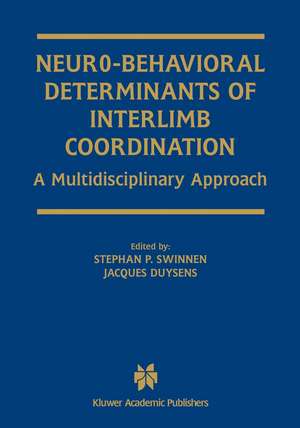Neuro-Behavioral Determinants of Interlimb Coordination: A multidisciplinary approach
Editat de Stephan P. Swinnen, Jacques Duysensen Limba Engleză Paperback – 20 noi 2012
| Toate formatele și edițiile | Preț | Express |
|---|---|---|
| Paperback (1) | 947.85 lei 43-57 zile | |
| Springer Us – 20 noi 2012 | 947.85 lei 43-57 zile | |
| Hardback (1) | 954.45 lei 43-57 zile | |
| Springer Us – 28 feb 2004 | 954.45 lei 43-57 zile |
Preț: 947.85 lei
Preț vechi: 1155.91 lei
-18% Nou
Puncte Express: 1422
Preț estimativ în valută:
181.39€ • 188.23$ • 151.61£
181.39€ • 188.23$ • 151.61£
Carte tipărită la comandă
Livrare economică 17-31 martie
Preluare comenzi: 021 569.72.76
Specificații
ISBN-13: 9781461347774
ISBN-10: 1461347777
Pagini: 368
Ilustrații: XXX, 329 p.
Dimensiuni: 155 x 235 x 19 mm
Greutate: 0.51 kg
Ediția:Softcover reprint of the original 1st ed. 2004
Editura: Springer Us
Colecția Springer
Locul publicării:New York, NY, United States
ISBN-10: 1461347777
Pagini: 368
Ilustrații: XXX, 329 p.
Dimensiuni: 155 x 235 x 19 mm
Greutate: 0.51 kg
Ediția:Softcover reprint of the original 1st ed. 2004
Editura: Springer Us
Colecția Springer
Locul publicării:New York, NY, United States
Public țintă
ResearchDescriere
Neuro-Behavioral Determinants of Interlimb Coordination: A multidisciplinary approach focuses on bimanual coordination against the broader context of the coordination between the upper and lower limbs. However, it is also broad in scope in that it reviews recent developments in the study of coordination by means of the latest technologies for the study of brain function, such as functional magnetic resonance imaging, near-infrared spectroscopy, magneto-encephalography, and transcranial magnetic stimulation. In addition, new developments in recovery of interlimb coordination following spinal cord injury and other insults of the central nervous system, such as stroke, are reviewed.
Neuro-Behavioral Determinants of Interlimb Coordination: A multidisciplinary approach is intended to be a helpful source of information for scientists in basic research as well as practioners involved in clinical settings. Those who will benefit most are neuroscientists, neurologists, neuropsychologists, cognitive neuroscientists, kinesiologists, motor and rehabilitation scientists, physical therapists etc. Special efforts have been made to make the contents accessible to graduate students by means of review chapters that contain explanatory boxes. We hope to convey our excitement and enthusiasm about the field of interlimb coordination and what it has to offer as a prototypical vehicle for a cognitive neuroscience approach to movement control.
Neuro-Behavioral Determinants of Interlimb Coordination: A multidisciplinary approach is intended to be a helpful source of information for scientists in basic research as well as practioners involved in clinical settings. Those who will benefit most are neuroscientists, neurologists, neuropsychologists, cognitive neuroscientists, kinesiologists, motor and rehabilitation scientists, physical therapists etc. Special efforts have been made to make the contents accessible to graduate students by means of review chapters that contain explanatory boxes. We hope to convey our excitement and enthusiasm about the field of interlimb coordination and what it has to offer as a prototypical vehicle for a cognitive neuroscience approach to movement control.
Cuprins
Explanatory Boxes. Contributing Authors. Preface. Acknowledgements. Prologue; S.P. Swinnen, J. Duysens. Part I: Interlimb Coordination: Neural Networks for Locomotion and Processes of Functional Recovery. Sensory Influences on Interlimb Coordination During Gait; J. Duysens, S. Donker, S.M.P. Verschueren, B.C.M. Smits-Engelsman, S.P. Swinnen. Development of Interlimb Coordination in the Neonatal Rat; F. Clarac, E. Pearlstein, J.F. Pflieger, L. Vinay. Locomotor Recovery Potential after Spinal Cord Injury; V.R. Edgerton, N.J.K. Tillakaratne, A.J. Bigbee, R.D. de Leon, R.R. Roy. Spinal Networks Involved in Interlimb Co-ordination and Reflect Regulation of Locomotion; V. Dietz. Cortical Networks Associated with Locomotion in Man and Patients with Hemiparetic Stroke; I. Miyai. Part II: Bimanual Coordination: Neural Mechanisms and Behavioral Principles. Electrophysiological Approaches to Bimanual Coordination in Primates; O. Donchin, S. Cardoso de Oliveira. The Modulation of Excitability in Corticospinal Pathways during Rhythmic Movement; W.D. Byblow, G.N. Lewis, J.W. Stinear, R.G. Carson. Neural Networks Involved in Cyclical Interlimb Coordination as Revealed by Medical Imaging Techniques; N. Wenderoth, F. Debaere, S.P. Swinnen. Behavioral Principles of Interlimb Coordination; W. Spijkers, H. Heuer. A Cognitive Neuroscience Perspective on Bimanual Coordination and Interference; R. Ivry, J. Diedrichsen, R. Spencer, E. Hazeltine, A. Semjen. Dynamical Models of Rhythmic Interlimb Coordination; C.E. Peper, A. Daffertshofer, P.J. Beek. Index.
Recenzii
From the reviews:
"With this book the authors attempted to diminish the gap between different approaches towards the study of interlimb coordination. … In this respect, the authors succeeded in their intention to let the book be a helpful source of information for scientist in basic research as well as practitioners involved in clinical settings." (G. Koopmans, Journal of Chemical Neuroanatomy, Vol. 30, 2005)
"With this book the authors attempted to diminish the gap between different approaches towards the study of interlimb coordination. … In this respect, the authors succeeded in their intention to let the book be a helpful source of information for scientist in basic research as well as practitioners involved in clinical settings." (G. Koopmans, Journal of Chemical Neuroanatomy, Vol. 30, 2005)









